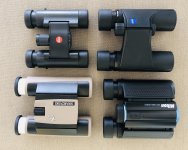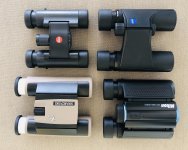After a few days using it, I think that you really need to know what you will using the Nikon 10x25 before buying them instead of say, the Zeiss 8x25 I also own.
In my case, it will be for archery, to better see where my arrows are and they will replace an old and relatively inefficient Minox monocular.
But for general use and unless you need x10 and IS to see the finest detail, the Zeiss are lighter, nicer to use, rubber covered, focuser is better, optics are a class above, FOV is much wider and they are much more "eyeglasses compatible".
And in low light, the Nikon are not really up to the task, I find them quite dark.
The Nikon are still a nice piece of technology and I like them more than the Canon IS I tried: compact, instant IS, better design.
In my case, it will be for archery, to better see where my arrows are and they will replace an old and relatively inefficient Minox monocular.
But for general use and unless you need x10 and IS to see the finest detail, the Zeiss are lighter, nicer to use, rubber covered, focuser is better, optics are a class above, FOV is much wider and they are much more "eyeglasses compatible".
And in low light, the Nikon are not really up to the task, I find them quite dark.
The Nikon are still a nice piece of technology and I like them more than the Canon IS I tried: compact, instant IS, better design.









